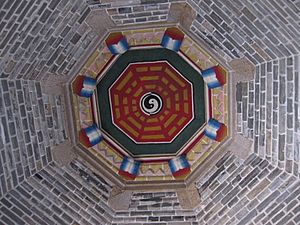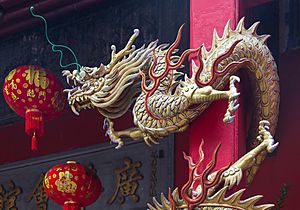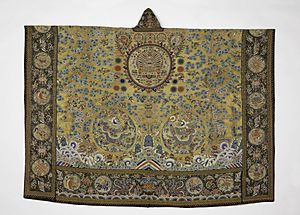Taoism facts for kids
Taoism or Daoism is an ancient way of thinking about life. It started in China over 2,500 years ago. Today, people often call it a philosophy, which means a way of understanding the world.
At the heart of Taoism is the idea of the Tao (pronounced "Dao"). This is like a natural "Way" or "Force" that Taoists believe makes everything in the world work. They think the Tao is so big and important that words can't truly describe it.
The most important book in Taoism is called the Dào Dé Jīng. It says that "the Way that can be explained in words is not the true Way." This means that understanding the Tao isn't about reading a lot of rules. Instead, it's about living in a certain way.
Taoism teaches people to live a simple and balanced life. They try to be in harmony with nature. This is one of the most important ideas in Taoism. Taoists also believe that fighting or conflict is not good. If there's a problem, they prefer to find a peaceful way around it.
Contents
History of Taoism
Taoism first appeared in writings in China about 2,500 years ago. But the ideas behind it might be even older. They could have come from very old folk religions in China.
Some important people are linked to the start of Taoism:
- Laozi, or Lao Tzu, is often seen as the founder of Taoism. People believe he wrote the Tao Te Ching.
- Zhuangzi, or Chuang Tzu, was another important teacher. His stories and sayings are also collected in a book.
- The Yellow Emperor, Huangdi, is sometimes thought to be the first Taoist. But it's not certain if he was a real person.
Taoist Beliefs and Practices
Taoists believe that certain actions, thoughts, or even symbols can make things happen in the real world. This idea can be a bit tricky to understand.
For example, there's an old story about a big flood in China. The hero, Yǔ, saved the world by digging ditches to let the water flow into the ocean. Taoist priests might act out what Yǔ did in a temple. They believe that doing this can help fix big problems in the world.
Taoist priests do many other things too. They might use fire and noise to scare away demons. They can also perform rituals to help cure sickness or guide spirits after someone dies.
A key idea in Taoism is that opposites need each other to exist. Think about big and small, or light and dark. They are different, but you can't have one without the other.
Nine Important Practices
Early Taoist schools taught "nine practices" or "nine virtues." These ideas came from classic Taoist writings, especially the Daodejing. They include:
- Non-action (wúwéi): This means acting naturally, without forcing things.
- Softness and weakness (róuruò): Being gentle and flexible, like water.
- Guarding the feminine (shǒucí): Valuing gentle and yielding qualities.
- Being nameless (wúmíng): Not seeking fame or recognition.
- Clarity and stillness (qīngjìng): Having a clear and calm mind.
- Being adept (zhūshàn): Being skilled in doing good things.
- Being desireless (wúyù): Not being controlled by strong wants.
- Knowing how to stop and be content (zhī zhǐzú): Knowing when enough is enough.
- Yielding and withdrawing (tuīràng): Being humble and stepping back when needed.
Taoist Symbols and Images

The Taijitu (often called the "yin and yang symbol") and the Bagua ("Eight Trigrams") are very important in Taoism. They show how the universe works. You can see these symbols on flags, temple floors, or even on special robes worn by priests.
The tiger and dragon are also old symbols in Taoism. The tiger represents yin, and the dragon represents yang. You'll often see these animals in Taoist art. Many Taoist temples have roofs decorated with colorful dragons, tigers, and phoenixes.
Taoist temples might fly square or triangular flags. These flags often have special writings or diagrams. They are used for different reasons, like guiding spirits, bringing good luck, or helping people live longer.
Drawings of the Big Dipper (a group of stars) are also important. In ancient China, people thought of the Big Dipper as a god. Later, it became a symbol for the Taiji idea. Another symbol is the flaming pearl, which stands for the pole star.
Symbols that mean long life and immortality are very popular. These include cranes, pine trees, and the peaches of immortality. Natural symbols like gourds, caves, clouds, and mountains are also common.
Taoist priests wear special robes, like the Daojiao fushi. These robes show their rank and which Taoist school they belong to.
Images for kids
-
Xianguting Temple, a Taoist temple in Weihai, Shandong, China.
-
A hall inside the Erwang Temple, a Taoist temple in Dujiangyan, Sichuan. You can see incense and candle offerings.
-
Confucianism, Taoism, and Buddhism are one, a 12th-century painting showing three men laughing by a river.
See also
 In Spanish: Taoísmo para niños
In Spanish: Taoísmo para niños













